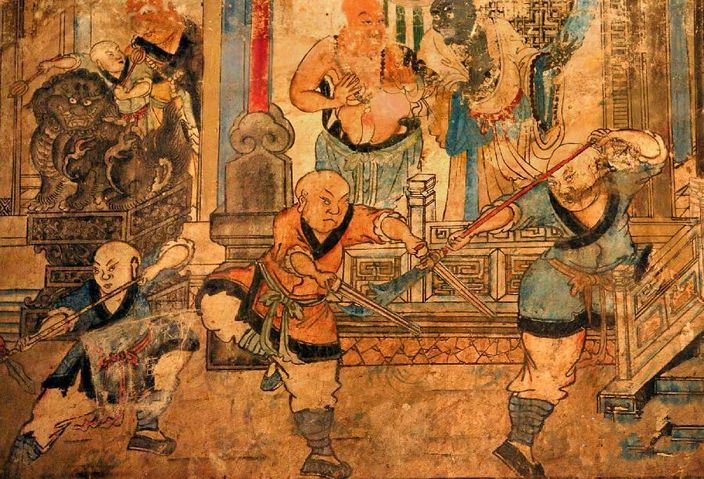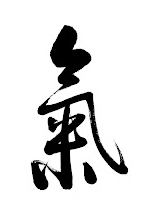Hong Kong cinema has undoubtedly influenced the current Western view of Chinese martial arts, a romantic view in which Kung Fu training is motivated by high values such as self-defense, health and self-realization, and away from the purpose of mere physical violence. But is this a vision adjusted to reality? Did a similar view of martial arts ever existed in China before the modern era?
Introduction:
Martial arts had their origin in the improvement of the methods of combat, or what is the same, in the optimization of the application of physical violence, annihilating the opponente and surviving. This has been the case throughout most of China's history, where the main objective of martial arts has been to develop combat effectiveness, either by the military classes, or by bandits, local forces, etc.
After the development of modern weaponry in the nineteenth and twentieth centuries, which rendered hand-to-hand combat obsolete, there has been an attempt to revalue traditional martial arts in search of a new significance; namely, health, self-defense and inner growth, the pursuit of a transcendent state of mind, and Kung Fu has been associated with a pathway to spiritual enlightenment, especially through its association with Shàolín 少林. Attention to these aspects that go beyond martial effectiveness increased markedly in this modern era.
However, and although this has a lot of a modern romantic myth, there are some historical precedents that contemplate certain martial practices as a way for self-improvement and link them, in some way, to spirituality.

Archery:
Archery has been of utmost importance in warfare throughout most of China's history, from remote antiquity to the nineteenth century; even after the appearance of the first firearms. But, in addition to its practical use, archery is probably the first martial discipline to be associated with a symbolic function.
Already in the Zhōu 周 dynasty, when archery competitions were a frequent pastime, they began to detach themselves from martial effectiveness, that is, from aim and piercing power, to become a demonstration of correct conduct. For Confucian thinkers, what prevailed in archery was the correction of form and not martial effectiveness. The correction of form demonstrated internal perfection and moved away from the mere ostentation of strength typical of the war archer.
Despite this, Confucian thinkers did not regard archery as a pathway to a higher state of mind. This idea first appears in the writings of the Taoists Zhuāngzǐ 莊子 and Lièzĭ 列子.
Lièzĭ and archery
In the Lièzĭ there is a story according to which Master Liè was demonstrating archery before Bóhūn Wúrén 伯昏無人. Lièzĭ was so skilled that he could place a cup of water on his elbow, and tighten the bow without spilling a drop, and he was also so fast that after firing an arrow, the next one was already in its place.
However, this ability did not impress Bóhūn Wúrén, a legendary character who represents Dào 道 itself. Wúrén (literally, "non-person"), asks Lièzĭ to climb a mountain and shoot from the top of a cliff. When Wúrén stood with half of his feet protruding into the abyss, Lièzĭ lay on the ground, sweating in panic.
In this story, Wúrén shows Lièzĭ that, although he has reached the physical ability of archery, he has not yet attained the Dào. Lièzĭ's inability to shoot from the top of the cliff is due to his mind being tense; he has attained external ability but has not mastered the subtle aspects.

Lièzĭ 列子.
This is one of the first indications of the idea that martial arts, through the perfection of skill, can lead to a perfection of the mental state. Thus, some people began to value a state of mind that would remain in time, above a physical ability that decreases with the age of the practitioner. It is noteworthy that this idea appears long before Chán 禪 and even before the arrival of Buddhism from India.
Due to the need for a serene state of mind in the practice of archery, it began to be seen as a way to reach that state. This vision of archery will remain throughout all the Chinese imperial era.
Martial dances:
Martial dances are the earliest demonstrations of martial skills without competitive purposes, but for ritual, spiritual and aesthetic ones.
Martial dances replicated the movements of combat and tried to induce a state of mind appropriate to the fight. These dances seem to have existed at least since the Spring and Autumn Period (春秋時代 Chūn-Qiū Shídài), and initially used the same weapons that were used in combat. In martial dances, meaning was detached from martial effectiveness to train mental, emotional and spiritual aspects.
Philosophers and thinkers:
The Confucianists, in their texts, used examples of martial skills to explain moral concepts; for them moral development was more important than the development of martial skills.
In the Warring States (戰國時代 Zhànguó Shídài) the awareness of the possibility of a martial practice for self-improvement developed among the warrior class. Martial arts require a clear and concentrated mind, the value of which goes beyond martiality itself. Moral virtue was considered more valuable and difficult to achieve than martial skill.
The jiàn:
We have already talked about the jiàn in our article History of the Jiàn or Chinese Straight Sword. However, we will summarize here the main ideas that interest us in this context.
The jiàn 劍 (straight double-edged sword) ceased to be used on the battlefield as early as the Hàn 漢 dynasty, and was replaced by the sabre (刀 dāo). Nonetheless, it remained a non-military weapon of scholars and court officials.
Likewise, the straight sword also persisted in sword dances and Taoist religious rituals, but was more related to aesthetics and ritual function than to self-realization.
However, in the Míng Dynasty the jiàn became the scholar's weapon, an association that would be maintained even after the Qīng 清 dynasty. Although it maintained a certain value in self-defense, it was the non-military character of the jiàn that allowed its use by the educated civilian classes without associating themselves with the military classes.

Some literati of the Míng period also practiced with other weapons, and some dedicated their lives to the search of martial knowledge, traveling through China in search of masters, without recording their motivations. It cannot be ruled out that these scholars sought some kind of self-knowledge through martial arts.
Although there is no evidence that the art of jiàn was associated with self-realization in the same way as archery, it is possible that this was the case, taking into account the amount of training necessary for its mastery, being a non-military weapon.
Modern era:
Since the nineteenth century, the attention paid to the spiritual aspects has been greater, since modern weaponry made hand-to-hand combat irrelevant in real battle. The emphasis on these aspects came from an educated minority, but it had a great effect on the spread of these new values or meanings. Since the vast majority of martial artists were illiterate, they could not record their perception of martial arts. It was precisely the educated minority that wrote about this and their writings were widely disseminated both inside and outside China, influencing our current perception of Chinese martial arts.
Internal energy exercises
Another important aspect was the association of martial arts with esoteric practices such as dǎoyǐn 導引 or Taoist internal alchemy (內丹 nèidān), in order to cultivate internal energy and improve health. This connection between martial arts and cultivation of internal energy would not be established until the early Qīng 清 dynasty (1644-1912) or, at the earliest, at the end of Míng 明 (1368-1644), and was especially promoted by the so-called "internal school" (內家 nèijiā). It is quite possible that it was the educated elite that integrated these disparate practices. There is no evidence of an earlier connection between them.
Already in the twentieth century, qìgōng 氣功 would claim descent from the ancient exercises of dǎoyǐn; however, it is impossible to prove this connection or the similarity between these two practices. In fact, the first recorded use of the term qìgōng dates back only to 1934. The only thing that links qìgōng with dǎoyǐn (or xíngqì 行氣) is the mention of qì 氣 or internal energy.

If we dismiss the emphasis on the conduction of qì, understood as internal energy, and contemplate qìgōng merely as a set of breathing exercises in motion, then it is likely that not only martial arts made use of these practices; other arts such as painting and calligraphy would also have employed them.
It is also interesting to note that the association of kungfu with meditation did not exist before the Míng dynasty, not even among the Buddhist community that practiced martial arts. Until then, even in cases where monastic communities became involved in war, martial skills had as their sole objective victory over the enemy.
The important thing here is the development of the idea of the possibility of acquiring a deeper knowledge of oneself through the practice of fighting techniques; this idea became more important as hand-to-hand combat lost relevance on the battlefield. The long Chinese martial tradition was redefined under a new light.
Already at the end of Qīng, martial arts were redefined according to the new ideas of Chinese nationalism. The emphasis on self-improvement was intended in some way to make a difference with Western sports practices. Lost its purpose in war, Chinese martial arts, as a cultural product of the Chinese nation, needed to be endowed with a practical sense in the new context of the twentieth century.
Conclusions:
While martial arts have always had a certain mental or attentional component, and although in ancient times some martial practices, such as archery, have been seen as pathways to self-improvement, this view of kungfu as a path to self-realization is a modern perspective.
Although some military institutions or members of these adopted certain divinities as protectors, or performed rites related to their martial activity, martial techniques were in no way derived from religion, nor were esoteric or mystical practices part of the training of a martial artist.
The war technology of the nineteenth and twentieth centuries left Chinese martial arts obsolete as a way of warfare. It then became necessary to find a new practical sense to keep alive these arts, a cultural relic product of the ancestral knowledge of the Chinese nation. This practical sense was defined in contrast to the Western vision of sport as mere physical exercise, placing special emphasis on certain internal components linked to the self-improvement of the practitioner, and linking martial arts to practices of cultivation of internal energy, such as qìgōng.
This vision would later be accentuated in the West, conditioning the way we understand Chinese martial arts today.
Sources:
- Breve Historia del Kung Fu, William Acevedo, Mei Cheung, Carlos Gutiérrez García. Ediciones Nowtilus, 2010.
- Chinese Martial Arts: From Antiquity to the Twenty-First Century, Peter Lorge. Cambridge University Press, 2012.
